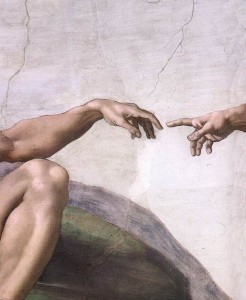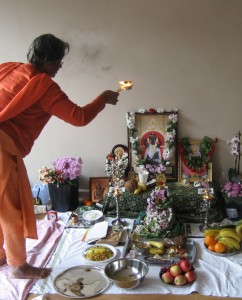 It might seem difficult to accept the Vedāntic assertion that knowledge is the one and only direct path to mokṣa. It might be difficult for some to accept that meditation isn’t a direct path to mokṣa, that yoga isn’t a direct path to mokṣa, that living a devotional lifestyle with prayer and hymns and attending temple / mosque / church isn’t a direct path to mokṣa. Too much has been invested in following these practices. So hearing that knowledge alone is what ultimately frees one from self-ignorance is something that raises resistance, because what’s meant by ‘knowledge’ is usually misunderstood. ‘The path of knowledge’ is seen as a dry undertaking that is suitable only for scholarly types, characterised by the need to understand Sanskrit, to follow convoluted arguments and study countless obscure texts. Continue reading
It might seem difficult to accept the Vedāntic assertion that knowledge is the one and only direct path to mokṣa. It might be difficult for some to accept that meditation isn’t a direct path to mokṣa, that yoga isn’t a direct path to mokṣa, that living a devotional lifestyle with prayer and hymns and attending temple / mosque / church isn’t a direct path to mokṣa. Too much has been invested in following these practices. So hearing that knowledge alone is what ultimately frees one from self-ignorance is something that raises resistance, because what’s meant by ‘knowledge’ is usually misunderstood. ‘The path of knowledge’ is seen as a dry undertaking that is suitable only for scholarly types, characterised by the need to understand Sanskrit, to follow convoluted arguments and study countless obscure texts. Continue reading
Author Archives: Peter
Why two lifestyles don’t mean two paths (1/2)
 One enduring misconception about enlightenment is that there are different ‘paths’ for different temperaments. This is not supported by Śaṅkara’s vision. Below the argument for the single ‘path’ is presented.
One enduring misconception about enlightenment is that there are different ‘paths’ for different temperaments. This is not supported by Śaṅkara’s vision. Below the argument for the single ‘path’ is presented.
1. All problems of life are due to an erroneous assumption about who one is. The solution to the problems of life, therefore, lies in correcting this erroneous assumption. Advaitins in the Śaṅkara tradition would agree with this.
2. Common observation supported by scripture shows that, when one’s aim is split, the goal is unlikely to be reached. So for seekers who are split between an avowed desire for self-knowledge and ‘compelling’ ties to the world in the form of emotional entanglements to people and places, unfulfilled duties, ambitions and the like, attaining the goal of self-knowledge is unlikely – their minds being impure (i.e. distorted by subjective likes and dislikes) or unsteady (unable to remain single-pointed for any length of time). The compelling pull of likes and dislikes that arise from duties and entanglements and ambitions is known as mala. And the flickering of the mind from one worldly demand to the other is called vikshepa. Continue reading
Logical enquiry into ‘Who I am’ (4/4)
 We started this enquiry into identity by employing a simple piece of logic: you cannot be what you observe. From this point of view, the things we normally take ourselves to be, starting with the body, were systematically discounted because they turn out to be objects of perception, as covered in the first three parts of this series. Despite this reasoning, the tendency to believe our identity with the amalgam of body, senses and mind tends to remains very powerful: we continue to believe that we are these individuals bound by skin, with an experiential history and an instinctive, habitual mindset through which ‘I’ filter the world.
We started this enquiry into identity by employing a simple piece of logic: you cannot be what you observe. From this point of view, the things we normally take ourselves to be, starting with the body, were systematically discounted because they turn out to be objects of perception, as covered in the first three parts of this series. Despite this reasoning, the tendency to believe our identity with the amalgam of body, senses and mind tends to remains very powerful: we continue to believe that we are these individuals bound by skin, with an experiential history and an instinctive, habitual mindset through which ‘I’ filter the world.
Identity with the body is evidenced by the vast cosmetic surgery industry today. People feel better with fewer wrinkles, larger breasts, drug-induced libido, less fat, etc. That’s the extreme end, but coming closer to the average person, we think of ourselves as too tall, too short, too hot or cold. If the body is in pain, we say: I am in pain. We really do mean ‘I’ when we say: I am hot, cold, ugly, beautiful, too short, too fat, too old. By employing the incontrovertible logic of ‘I cannot be what I can observe’, it does not take long for us to realise that the body is an object of perception: ‘I’ can experience my body using my five senses. We then ask: Who is observing the body? Continue reading
Logical enquiry into ‘Who I am’ (3/4)
 When we analysed the world of objects in the waking state we came to the understanding that our experience of the variety of objects is due to the variety of corresponding mental impressions (covered in Part 2 of this series). If there isn’t a mental impression ‘this is a pot’ then, despite fully-functioning senses, the pot will be as good as non-existent. The perception of ‘is-ness’ is the single, unchanging common thread in all our worldly experiences. This perception is given the name, ‘consciousness’.
When we analysed the world of objects in the waking state we came to the understanding that our experience of the variety of objects is due to the variety of corresponding mental impressions (covered in Part 2 of this series). If there isn’t a mental impression ‘this is a pot’ then, despite fully-functioning senses, the pot will be as good as non-existent. The perception of ‘is-ness’ is the single, unchanging common thread in all our worldly experiences. This perception is given the name, ‘consciousness’.
When we analysed our dream state experience we realised that the same observation holds true for the dream universe as for the universe we encounter when awake. This experience gives an added dimension to our understanding of consciousness: not only is it the one, unchanging basis of the varied, changing objects (gross and subtle), but now we see that it is also continuous through the changing states of experience. The ‘I’ that is awake is the same ‘I’ that dreamt: ‘I am awake, I had a dream’. Continue reading
Logical enquiry into ‘Who I am’ (2/4)
 In the first part of this enquiry we saw how, by discriminating between the seer and what’s seen, we arrive at the understanding that ‘I’, the seer, am not the body, not the sense powers, not the thinking faculty, not even a combination of all of them. They are all objects of my perception and I am the perceiving subject. And I, the subject, cannot be what I can perceive as an object. In this logical way we arrived, step-by-step, at a final ‘knower’, which is given the name ‘pure consciousness’. This pure consciousness is what remains after thoughts, (which are the subtlest objects of perception), have been dismissed as the ultimate ‘I’. We know there’s something there but it is still a bit hazy. We now need to test the robustness of our new working conclusion that this ‘pure consciousness’ is the ‘I’ we are searching for and sharpen the understanding.
In the first part of this enquiry we saw how, by discriminating between the seer and what’s seen, we arrive at the understanding that ‘I’, the seer, am not the body, not the sense powers, not the thinking faculty, not even a combination of all of them. They are all objects of my perception and I am the perceiving subject. And I, the subject, cannot be what I can perceive as an object. In this logical way we arrived, step-by-step, at a final ‘knower’, which is given the name ‘pure consciousness’. This pure consciousness is what remains after thoughts, (which are the subtlest objects of perception), have been dismissed as the ultimate ‘I’. We know there’s something there but it is still a bit hazy. We now need to test the robustness of our new working conclusion that this ‘pure consciousness’ is the ‘I’ we are searching for and sharpen the understanding.
For this we need to understand the nature of consciousness and its relationship, if any, with ‘I’. A question might arise at this point: If ‘I’ is the pure consciousness that remains in the absence of vṛtti-s (thoughts), and no cognition is possible without vṛtti-s, then how can I ever know what I am? How do we go further with this enquiry if there are no thoughts? Continue reading
Logical enquiry into ‘Who I am’ (1/4)
 At some time or other in every person’s life the question of identity arises in some form or other. For most people, the answer seems pretty obvious: I am a unique human being, a man/woman, in this body, with these parents, these siblings, and these ideas. I am defined by my wealth, my social class, my education, my tastes, my network of contacts, my race. I am shaped by my biology, my physiology, my psychology. Anything beyond this is ‘philosophy’, and one thing I am not is a philosopher!
At some time or other in every person’s life the question of identity arises in some form or other. For most people, the answer seems pretty obvious: I am a unique human being, a man/woman, in this body, with these parents, these siblings, and these ideas. I am defined by my wealth, my social class, my education, my tastes, my network of contacts, my race. I am shaped by my biology, my physiology, my psychology. Anything beyond this is ‘philosophy’, and one thing I am not is a philosopher!
If, however, people knew the life-changing value in finding the true answer to the question, ‘Who am I?’ they might be prepared to dig a bit deeper for that truth. Vedānta gives us a very good reason to pursue the question. It says that because we do not know the truth of who we are, we take ourselves to be an amalgam of the body and mind (thus pretty much confirming the majority view). The inevitable consequence of identifying with something that is as changeable, limited and vulnerable as the body and mind, is that ‘I’ is also taken to be changeable, limited and vulnerable. And it consumes a whole life of sweat and slog in trying to build up adequate self-protection. Continue reading
Discovering oneself: Part 2/2
 So how do we know how Brahman is? The teacher says that each object of experience has 5 aspects: asti, bhāti, priyam, rūpam, nāma. Asti = ‘is’. You know the meaning of the word ‘cat’, but not pay attention to the meaning of the word ‘is’, which means ‘isness’, which means ‘existence’. When you say ‘cat is’ you mean that the existence of the cat is. Any object of experience you can name is.
So how do we know how Brahman is? The teacher says that each object of experience has 5 aspects: asti, bhāti, priyam, rūpam, nāma. Asti = ‘is’. You know the meaning of the word ‘cat’, but not pay attention to the meaning of the word ‘is’, which means ‘isness’, which means ‘existence’. When you say ‘cat is’ you mean that the existence of the cat is. Any object of experience you can name is.
Existence is the intrinsic nature of Brahman, the Reality. In what form is Brahman? Continue reading
Discovering oneself: Part 1/2
 Samsāra, this life of limitations, this life of transmigration, is because of the lack of discriminative knowledge of what Self is and what it is not. That ignorance is caused by the covering power of māyā, which covers internally and externally: internally it covers the discrimination between the seer and the seen, and externally it covers discrimination between the Reality and the creation.
Samsāra, this life of limitations, this life of transmigration, is because of the lack of discriminative knowledge of what Self is and what it is not. That ignorance is caused by the covering power of māyā, which covers internally and externally: internally it covers the discrimination between the seer and the seen, and externally it covers discrimination between the Reality and the creation.
Internally, delusion causes error such as: ‘I am insecure, dependent, unhappy, limited, etc.’ These wrong notions are caused by lack of discriminative knowledge at the individual level. Externally it takes the form: ‘this universe is the source of happiness, it is responsible for my unhappiness, I am dependent on the universe, the universe will give me security, etc.’ (The universe includes friends, relatives, property etc).
One’s notion about the self (internal) is wrong and notion about the universe (external) is also wrong. Every human being makes this common error. These erroneous notions are caused by lack of discriminative knowledge. We do not have discrimination regarding what is absolutely true and what is ‘as though’ true in the universe, hence we have a wrong notion about the universe. Continue reading
Puruṣārtha-niścaya, the beginning of the beginning
 What is puruṣārtha-niścaya? Of the two words, niścaya has a close English equivalent: certainty, conviction, unshakable clarity. So puruṣārtha-niścaya mean ‘doubt-free clarity and unshakable certainty’ about puruṣārtha. So what is this thing one has no doubt about?
What is puruṣārtha-niścaya? Of the two words, niścaya has a close English equivalent: certainty, conviction, unshakable clarity. So puruṣārtha-niścaya mean ‘doubt-free clarity and unshakable certainty’ about puruṣārtha. So what is this thing one has no doubt about?
Puruṣārtha is a compound made up of two words: puruṣa and artha. Puruṣa also has a close English equivalent: ‘person’, ‘human being’ (albeit with a lot behind it that reminds us of the true scale of what is indicated by the word – see footnote at the end).
Thus, so far, we have arrived at this meaning: ‘unshakable certainty about human artha’.
Artha is the last word that needs unpacking. Normally translated as ‘wealth’ or ‘meaning’, here it should be read as ‘aim or purpose’.
Puruṣārtha is the purpose of the human life. And puruṣārtha-niścaya is total clarity about what this purpose is – about what defines human life and drives human activity. Continue reading
Īśvara (The Lord), prayer and worship 2/2
In the previous extract from her talks to London students, Swāminī Ātmaprakāśānanda, laid out a more liberating vision of Íśvara – liberating in the sense that it gets away from the old man in the sky image or some force-field etc. From the perspective of traditional advaita vedānta Íśvara is seen as the sum total of the universal natural law and order.
“Every natural law is Īśvara. The law ordaining grace is Īśvara. Action is Īśvara. The results of actionis Īśvara. Merit is Īśvara. Demerit is Īśvara. Pain is Īśvara. Pleasure is Īśvara. Right and wrong action is Īśvara. Punishment for the wrong action is Īśvara. Good is Īśvara. Evil is Īśvara – don’t say that evil is not God. Everything is Īśvara.”
The universal law and order is what determines the fruits of actions. You can’t see this with physical eyes, but you can understand the laws being manifest. Anything done, knowingly, unknowingly, intentionally, unintentionally – however it is done – any action has to result in a reaction, has to cause some effect.
If this be the case, what is the role of prayer or worship? With simple logic and reason Swaminiji once more breaks down resistance to these activities… Continue reading

